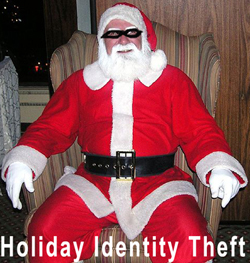Holiday Shopping Invites Retail Fraud
November 16th, 2009 Phil Britt
U.S. merchants are incurring $191 billion in fraud losses each year, according to a new study from LexisNexis Risk Solutions that was released just as many merchants were putting out their holiday displays.

Holidays Invite Identity Theft
Among the findings, the 2009 LexisNexis True Cost of Fraud Benchmark Study discovered that merchants must absorb nearly 10 times the identity fraud cost incurred by financial institutions. Retail merchants experience a massive $100 billion in losses solely attributed to identity fraud, which escalates to $191 billion when factoring in the additional cost of lost and stolen merchandise. The study also found that merchant fraud losses amounted to more than 20 times the total value of consumer fraud victim losses, which totaled approximately $4.8 billion in 2008.
“The impact of retail fraud is multifaceted and far-reaching, as this crime claims multiple victims,” said Dennis Becker, LexisNexis Risk Solutions vice president, corporate markets. “We are seeing significant increases in identity fraud overall as well as increases in typical fraud categories such as chargebacks. With the economic downturn and increasing sophistication in criminal fraud methods, it is crucial that merchants and financial institutions work together to mitigate fraud.”
According to the study, retail merchants are absorbing the vast majority of the costs associated with fraud. Among the numerous fraud types affecting merchants, identity fraud or fraudulent transactions made up the bulk of fraud from a cost standpoint, representing 52 percent of total fraud losses.
Additionally, certain merchant segments revealed a higher prevalence of fraudulent transactions such as large eCommerce retailers, of which 40 percent saw an upsurge. Digital goods merchants attributed 54 percent of their fraud loss to unauthorized purchases, while merchants in telecom, social networking industries and online gaming reported 64 percent to 67 percent of their total annual fraud loss as the result of identity fraud.
While merchants and card issuers tend to absorb most of the fraud costs, there are numerous indirect costs that affect consumers as well: • The cost of fraud losses is passed along in the form of higher prices. Card issuers increase fees to merchants, who in turn pass them on to customers, as fraud increases.
• If a payment card is lost or stolen and then used by a fraudster, it takes time to close accounts, open new ones and clear up any unauthorized charges, even if there is no direct financial loss to the consumer (most credit card issuers absorb all losses).
• A stolen payment card can be the first step in more thorough identity theft.
Therefore, it is more important than ever that consumers protect their payment cards in order to protect their identities. Among the important safeguards a person can take: • Rather than signing your name, put “Ask for Identification” on the signature line. Granted, not all register operators check the signature on the back (even though they are supposed to) and there are plenty of self-service registers (including gasoline pumps) and online merchants where no signature is required. But the “Ask for Identification signature” can still provide some additional protection.
• Regularly examine card statements for unauthorized charges.
• Don’t leave a card where others can see it. It only takes seconds to see the critical information on the front, and a little more time for a fraudster to quickly turn the card over and obtain the authorization code from the back. With this information, the fraudster can make countless online purchases.
• If fraud is detected, contact the issuer immediately.
• If fraud is detected, inspect other statements to determine if the fraud is limited only to the card or if your identity has been compromised across multiple accounts. If your identity has been compromised, contact the three credit bureaus and consider putting a freeze on your credit reports.
|


